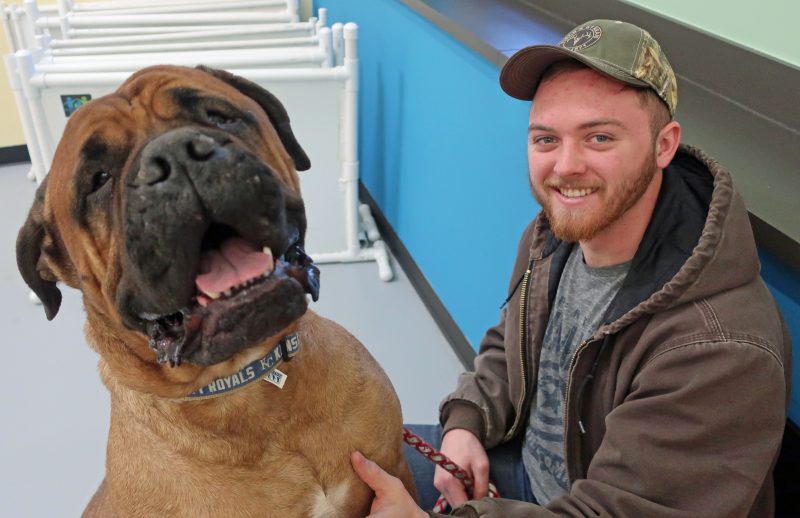It’s never an easy thing to do. People who come to us to relinquish their pets are never just getting rid of a pet because they’re tired of it. They’re struggling, and they’re making an incredibly hard decision.
As an example, look at our friends Marie and Precious (pictured above). We actually ran into them at KC Pet Project, where Marie was looking to surrender Precious. The reason? Precious was in pain because she needed some dental work. Marie couldn’t afford it, so she wanted to at least take her companion someplace that would be able to help her out, even if it meant she’d have to give her up.
Imagine what it takes to make that sacrifice. Precious helped Marie through the difficulty of chemotherapy. She was Marie’s lifeline, her companion. Still, Marie was willing to give Precious up to make sure she wasn’t in pain anymore.
We were able to intervene, thankfully, and get Precious the help she needed. Now she and Marie are still together, a happy family.
This is what we call shelter intervention. A little bit of help is often the only thing that’s needed to help folks over the hump. If we’re able to jump in and provide assistance, we keep that pet in a loving home, instead of them being surrendered and ending up in a brand new place, or worse yet, languishing in a shelter for a long time.
—–

To understand how we can prevent folks from relinquishing their pets, we need to first understand its root causes.
We have a lot of experience working with folks who are wanting to relinquish pets, and it’s easy to form opinions about certain things based on anecdotal data. Not that our own experiences don’t count here, but we figured that looking at some scientific research on the issue might help us better understand the underlying causes.
Going back a ways, a 1999 study done by the National Council on Pet Population Study and Policy (NCPPSP), looking at relinquishment in 12 shelters across the nation, has some interesting things to say. Not necessarily about the reasons for relinquishment, though these are important, but more about the characteristics of the pets that were relinquished.
Some stats:
- Most of the surrendered pets were between 5 months and 3 years of age
- Most of them had only been owned from 7 months to 1 year
- About half of them hadn’t been fixed. And about a third of dogs and almost half of cats had never been to veterinarian
- The vast majority of dogs had not ever had obedience training
What does this tell us? Young energetic pets, unaltered, dogs with no training, and many of them being surrendered relatively early on in their time in their new home. Well, the first thing we can see is that them being unfixed could absolutely be part of any behavioral problems. But the lack of training is a real problem too. That’s one of the reasons we offer low-cost dog and puppy training classes at our clinic. Too often we see folks who clearly love their dog, but don’t know how to communicate very well with them. Training helps owners and dogs understand each other better so that everybody’s happier.
——

In another study of relinquishment, this time in 2015 at an LA municipal shelter, the idea was that, in a high-poverty area, what does relinquishment look like? Is it easier to see the patterns that cause people to relinquish when they don’t want to?
When asked what had changed in the household to make them consider this change, the main answers were “inability to pay for care” (by a large margin), then “landlord issues,” then “behavioral issues.” This is no huge surprise. Again, we see behavioral issues that could possibly be solved through training; only one single respondent said they knew of a place where they could get free behavioral training.
Landlord issues are a tough one, honestly, because apart from legislation to force landlords to accept pets, there’s not a whole lot to be done, and in truth, often folks are moving from one rental property to another, and since their income only allows them to choose from a few different places, they may not have a choice but to go with a place that doesn’t allow pets. It may be their only option.
This area that was surveyed for this study was also under a mandatory spay/neuter ordinance, meaning that all pets had to be fixed or risk impoundment. This has a strong impact on communities, and not in a good way, as we’ve talked about before. If there’s no money to get the surgery done, then there’s no choice but to relinquish the pet or keep them hidden (meaning the pet won’t get the vet care they need).
But honestly, what’s the most striking is how many people coming to surrender their pets didn’t know about the resources available to them. Of the people surveyed, 80.7% didn’t know of any services that were available to help them, even though the shelter that they were going to had a third-party group on-site to help with resource issues. But upon reflection, this makes sense. Underserved communities are deserts when it comes to access to assistance, or even just having access to the knowledge that help is out there.
Poverty isolates. Of the respondents to the survey, 88% chose to pursue assistance once they realized it was available to them. These are people who want and sometimes need that companionship that a pet provides, but circumstances have gotten in the way. It can happen to anybody.
So in the end what we see is that having groups like us around to provide assistance and making people aware of resources available can make all the difference, keep pets in loving homes, and keep shelters open for pets that are truly homeless. The trick is to provide help wherever you can, because the reasons for relinquishment, while they all come from poverty and lack of resources, take many different forms.


